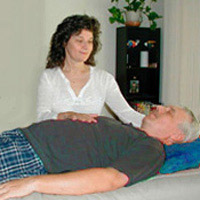


Acupressure Overview
Acupressure (Jin Shin Do) is a holistic (meaning the person is treated as a whole being both physically and emotionally) form of pressure massage using fingers and hands that combines aspects of Japanese Acupressure (Jin Shin Jitsu) and Chinese Acupuncture Theory, with Energy Techniques somewhat similar to Reiki, to help release blocked patterns of energy in the body. The treatment is designed to harmonize and replenish the “Chi”, which is the intrinsic, vital energy of the body. The person being worked on releases tensions,vand frequently goes into a very deep state of relaxation, in which it is easier for them to let go of chronic or deeply-held patterns of pain, tension, or emotional stress held in their body.
Acupressure points are spots where the Chi comes to the surface of the body.
Stimulating these points, particularly in conjunction with other points along
the same Meridian, (Meridians are the "lines" which the Chi runs along for each organ in the body) releases blockages in the flow of “the current”,
(similar to the flow of electricity), so the Chi once more flows freely along
the channels; This “release” of Chi on a blocked channel can
frequently be felt as a pulsing wave, or, at least, as a letting go of tension
along those points.
In Chinese medicine Theory, there are twelve of these channels called Meridians:
Heart, Pericardium, Small Intestine, large Intestine, Liver, Lungs, Stomach,
Spleen, Gall Bladder and Triple Warmer. Each Meridian is assigned different
functions and associations in the body, and is connected, also, to specific
bodily functions and emotions as well as to a specific organ.
After the visiting client has told the Practitioner his physical (or emotional) symptoms, the Practitioner does a check of the balance of these Meridians by taking the twelve “pulses” that all reside in the wrist, and determining where the imbalances reside. These may already be apparent by the client’s symptoms, though assessing the pulses can detect imbalances BEFORE the bodily symptoms appear, and can frequently prevent them.
I call my practice “holistic” not only because the emotional symptoms and the physical are treated in an interconnected way, but also because I believe in looking at a client’s diet, physical exercise regimes, sleep patterns, and daily routines (such as sitting and working at a computer, driving, or carrying a heavy purse) as part of treatment analysis.
